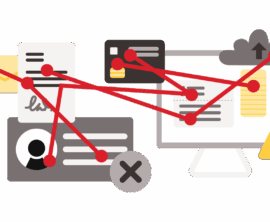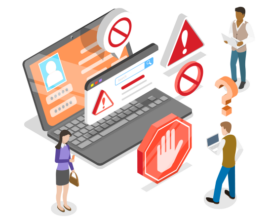Key takeaways
- Scammers often target vulnerable people during or after a disaster, like a hurricane, wildfire, or flood, with a sense of urgency amid the chaos.
- Individuals should always verify the legitimacy of any organization or individual requesting personal information or payment, and avoid making payments through wire transfers, gift cards, cryptocurrency, or cash, as these are difficult to recover once sent.
- Small business owners can prepare by creating an emergency contingency plan, knowing their employees, and reviewing insurance policies.
During the chaos, fear, and urgency resulting from extreme natural events, the last thing most people are thinking about is getting scammed. But this is exactly the environment that con artists gravitate toward. In fact, the National Insurance Crime Bureau estimates as much as 10% of the $93 billion in catastrophe losses in 2023 were subject to fraud.
Often people don’t know how to properly file an insurance claim or access government assistance programs, which leaves them vulnerable to dishonest individuals. “A scammer’s goal is to get your money or steal your identity,” warned Margarita Alvarez, head of Payment Risk Programs at Wells Fargo. “They will do this directly through a payment of some sort or by deceiving you to give up your personal or financial information. They may also pose as you to receive funds intended for you.”
In addition to the below tips, you can find more resources in the Wells Fargo Security Center.
How to spot a scam
Scammers may pose as insurance servicers, government employees, aid workers, or bank employees to gather personal and financial information or get your money in a variety of ways, but the most common hallmark of a scam is a sense of urgency. The scammer pressures you to act immediately, often with threats or promises of a deal, demanding payment through unconventional methods, and requesting sensitive personal information without a legitimate reason.
“They’ll take advantage of the criticalness of the moment and purposefully not give you time to think, verify their claims, or consult someone else,” Alvarez said. “So slow down and think through the ask.”
Stay informed through trusted sources for updates from local officials on relief efforts and trending scams. “And remember, if it seems too good to be true, it probably is,” Alvarez said.
“[Scammers will] take advantage of the criticalness of the moment and purposefully not give you time to think, verify their claims, or consult someone else.”
Recognizing these common tactics can help you avoid being a victim:
- Spoofing legitimate phone numbers by altering caller ID. If you receive a robocall promising government grants, flood insurance, or help with applications for assistance, don’t provide personal information or payment. They may be scams trying to get your credit card or checking account information. Verify by looking up an organization’s telephone number on their website and calling directly.
- Requesting your personal details to apply for assistance or grants. Never give your financial information to anyone you don’t know and don’t submit anything on a website without a security certificate, indicated by “https” in the URL. Disaster relief workers will never ask for your Social Security number, bank account, or other sensitive information.
- Demanding immediate payments. An insurance or utility company impersonator may offer to maintain coverage or expedite repairs due to the disaster.
- Insisting on payment by wire transfer, gift cards, cryptocurrency, or cash. These are immediate forms of payment, making the funds very hard to recover once the money has left your account.
- Claiming to stop fraud on your bank account. You are asked to provide account information, transfer funds elsewhere, send a wire payment, or withdraw funds in person and send elsewhere.
- Spoofing legitimate email addresses. If you receive a suspicious phishing email requesting donations or other assistance, do not click on any links or open any attachments, which could spread malware on your devices.
FEMA scams
Posing as Federal Emergency Management Agency (FEMA) employees, fraudsters request application fees to submit claims to insurance. They may also apply for FEMA assistance using stolen names, addresses, and Social Security numbers.
Don’t fall for it
- FEMA will never charge you for disaster assistance and will not solicit or accept money — nor will any other federal agency.
- Always ask for identification. FEMA personnel should have an official ID badge.
- If a FEMA inspector comes to your home or you receive a letter from FEMA and you did not already apply for FEMA assistance, contact FEMA directly.
- Beware of door-to-door solicitors. FEMA does not license, endorse, or certify contractors. Research local contractors who are authorized to do work in your area.
- Guard your personal and financial information: Don’t give out usernames, passwords, PINs, or one-time passcodes.
If you think you’ve been scammed, call the FEMA Disaster Fraud Hotline at 1-866-720-5721.
Disaster relief charity and crowdfunding schemes
Scammers will seize any opportunity to tug on your heartstrings to trick you into sending money to support a seemingly good cause. These scams are especially rampant after natural disasters or other tragedies. Grifters may impersonate official entities, celebrities, influencers, or other individuals to solicit donations, many times through crowdfunding accounts, like GoFundMe. They may also create sham charities, use materials they steal from others, or use AI tools to create fake images of first responders or disaster scenes.
These schemes have gained traction on social media, where users can be directed in just a few clicks to donate using credit cards, debit cards, or cryptocurrency.
Don’t fall for it
- Donate to well-known, trusted charities. Verify legitimacy through Better Business Bureau’s Wise Giving Alliance, Charity Navigator, Charity Watch, or GuideStar. Confirm if a charity is registered in your state or required to be with the National Association of State Charity Officials.
- Verify the legitimacy of the crowdfunding source and that funds are truly going to the intended beneficiary.
- Ask how the money will be spent or say that you want to research their organization online first. If they can’t tell you how your money will be used or they pressure you to donate in the moment, rethink your donation.
- Request the charity’s exact name, street address, phone number, and web address, then call the charity directly and confirm that the person asking for funds is an employee or volunteer.
- Use only official and secure websites, indicated by “https” in the URL.
- Do not pay with cash.
- Get a receipt with the charity’s name, street address, phone number, and web address.
Damage repair scams
Scammers posing as contractors promise quick fixes or debris cleanup but leave behind shoddy work. After they receive payment, the work never gets done. Common tactics include:
- Offering free inspections and finding “significant damage.” They assure the homeowner their insurance will cover repairs or reimburse them.
- Offering debris cleanup or discounted repairs because they have “leftover material from a previous job.” These offers come with high-pressure sales tactics and usually the request for immediate payment and a signed contract.
- Offering “limited time only” deals or scarcity tactics that claim the price of materials will rise if you don’t act now. And be suspicious of anyone offering to “move you to the front of the line.”
- Waiving the insurance deductible, which entices the homeowner to sign over insurance claim checks.
- Insisting on payment by wire transfer or in gift cards, cryptocurrency, or cash.
Don’t fall for it
- Verify insurance coverage: Do not rely on contractors to tell you what is covered.
- Be skeptical and cautious of anyone promising immediate cleanup or repairs.
- Check contractor’s licenses and insurance. In some states, it is a felony for building contractors to operate without a license in a declared disaster area.
- Get multiple estimates and a written contract. Read carefully to ensure all the details are included before you sign.
- Don’t be rushed or pressured into making any type of payment transaction.
- Never pay via wire transfer, gift card, cryptocurrency, or in cash. Instead, opt for paying with credit card or debit card, both of which offer consumer protections.
- Never make final payment until the agreed-upon work has been completed.
- Keep all job-related paperwork.

Housing scams
Renters and homeowners are especially vulnerable after a disaster. Here’s what to look out for:
Rental scams
Swindlers post fake rental property ads with photos and descriptions of actual homes, often with the allure of a deep discount. Once you express interest, you’re pressed to send money right away as a deposit or to provide personal information for a fake application. Once the money is sent and/or the application is filled out, they disappear with your money and your personal information, which can then lead to identity theft.
Mortgage scams
After a disaster, con artists may offer you assistance with negotiating or delaying your mortgage payments through foreclosure relief scams. Generally, lenders or mortgage servicers will work directly with homeowners after a natural disaster and offer forbearance or other hardship options to help you avoid going into default or ending up in foreclosure. Your payment assistance options should always be discussed directly with your mortgage servicer. Never pay a company to negotiate with your servicer on your behalf.
If you need help working with your mortgage servicer, you may want to contact a housing counselor. Wells Fargo customers may be eligible for help with payment challenges.
Don’t fall for it
- Avoid listings requiring immediate action.
- Research the property and owner. Meet in person to see the rental before you pay or sign a lease. If you can’t, keep looking.
- Don’t pay by wire transfer, gift card, or cryptocurrency.
- Never deal with a third party claiming to be an insurance adjuster without verifying their identity with your insurance company.
- Look out for price gouging, which can be illegal during a state of emergency in some cases and states. Familiarize yourself with local housing laws. Take a photo of the prices, just in case.
- Be alert if a housing inspector asks for your nine-digit registration number. FEMA home inspectors already have this information and will not ask for it.
Small business scams
When a business of any size is damaged by a natural disaster, there is often immense pressure to quickly rebuild, making owners and employees susceptible to rushed decisions and overlooking red flags. Impersonating contractors, insurance companies, FEMA, SBA, and other agencies, skilled disaster recovery scam artists see small business owners as easy prey.
“Our customers’ employees who were victims of disaster scams tell us this happened for one of two reasons: They didn’t know the signs, or they knew but let their guard down,” said Alvarez.
Here are things to keep in mind for a smoother recovery.
Listen: Favorite fraud targets for today’s cybercriminals
Wells Fargo fraud education and cybersecurity professionals discuss the impact of artificial intelligence in the fraud space and how to protect your company’s most vulnerable entry points from payments fraud and more.
Common types of fraud targeting small businesses
- FEMA, SBA, and other government aid scams: Scammers pose as government officials to gain access to sensitive information or demand payments for disaster aid that should be free.
- Contractor scams and price gouging: Unscrupulous individuals may inflate prices, lie about work that doesn’t need to be done, or provide substandard work, taking advantage of the need for immediate repairs.
- Phishing scams: Emails or text messages appearing to be from legitimate disaster relief organizations contain malicious links to malware.
- Identity theft: Scammers use stolen personal information gained from the above methods to file fraudulent claims or access disaster relief funds.
Fraud prevention strategies for small businesses
- Develop an emergency contingency plan. Work with your team to identify potential vulnerabilities or “what if” scenarios, and determine how to respond. Test your employees and your systems with realistic drills at least once a year, adjusting as necessary.
- Do your due diligence. Before doing business with a new company, search the company’s name plus the term “scam” or “complaint.” Read what others are saying about that company.
- Ask people you trust for recommendations. Get free business recovery advice and counseling through programs like SCORE.org.
- Know your employees. If you have staff and contractors coming and going after a disaster, be vigilant about verifying everyone’s identity. Perform credit and background checks on all new employees who have access to your accounts, records, or cash.
- Train staff not to leak sensitive information. This includes sending passwords, IDs, token codes, or other authorization credentials they use to access company online banking systems or accounts by email, even if the request seems to come from a manager. Explain how scams happen and encourage them to confer with their coworkers if they suspect a scam.
- Clarify procedures for approving purchases and invoices. Ask your staff to check all invoices closely, paying particular attention to the method of payment.
- Strengthen internal controls. Implement dual custody on all online payment services (ACH, wire transfer, foreign exchange) and administration services; reconcile accounts daily to detect suspicious activity; lock check stock and signature stamps in a secured location; and update antivirus software, antispyware, and firewalls regularly.
- Keep authorizations up-to-date. When an authorized signatory or approver on your accounts leaves your company, notify your bank immediately to have that employee’s name removed from all authorizations.
- Ask to see a badge. All federal employees carry official, laminated photo identification.
- Cross-reference any information you receive by email or online. For example, ensure that the referenced application number is consistent with the actual application number.
- Maintain good recordkeeping. Keep detailed records of damages, repairs, and invoices to prevent fraud.
- Review insurance policies. Understand your coverage and reporting procedures for disaster-related claims.

Red flags of small business fraud
FEMA, SBA, and other government aid scams
- You are contacted by someone promising to get approval of an SBA loan but requires upfront payment or offers a high-interest bridge loan in the interim.
- You are in the process of applying for an SBA loan and receive email correspondence asking for personally identifiable information (PII).
- You are tricked into paying to apply for so-called business grants from fake government programs.
Remember: SBA representatives never charge applicants for disaster assistance, inspections, or help in filling out applications. Federal and local disaster workers do not solicit or accept money. FEMA inspectors verify damage, but do not hire or endorse specific contractors to repair damaged property or recommend repairs. They do not determine your eligibility for assistance and will never ask for banking or other personal information.
Contractor scams
- A “contractor” arrives at your door, offering to cut you in on the fraud. For example, they’ll do the $25,000 worth of work that is actually required, bill your insurance company for $50,000, and then say they’ll split the difference with you.
- A “contractor” shows up to do the first two or three days’ worth of work or uses substandard materials, and then disappears.
- Someone demands that you pay via wire transfer, cryptocurrency, or gift cards.
Phishing scams
- You receive a call from a utility company saying your gas, electric, or water service is about to be interrupted because of a fake late bill. You’re asked to pay immediately.
- You receive an email, phone call, or text message claiming to be from your financial institution, asking for your credentials.
- Your business receives unsolicited phone calls or emails asking about employees or other internal information.
How businesses can handle and report fraud
- If you suspect identity theft related to SBA programs, visit U.S. Small Business Administration (SBA) and Federal Trade Commission (FTC).
- Report fraud, waste, abuse, or mismanagement of federal funds involving SBA programs, operations, or personnel to the SBA Office of Inspector General Hotline.
- If you spot a scam, report it to ReportFraud.ftc.gov.
- Alert your state attorney general at NAAG.org.
Disaster fraud FAQs
Disaster fraud is when people take advantage of survivors of hurricanes, earthquakes, floods, wildfires, and other natural catastrophes, through scams and identity theft. They will do this directly through a payment of some sort or by deceiving you to give up your personal or financial information. They may also pose as you to receive funds intended for you.
Ask to see ID. According to FEMA, personnel will always have an official identification badge; a FEMA shirt or jacket is not proof of identity. FEMA inspectors will already have your nine-digit registration number and will never ask for money or personal information like your Social Security number. If you receive suspicious FEMA emails or phone calls, call the FEMA Helpline at 1-800-621-3362 to verify.
- Claims that a contractor doesn’t need a license to do the work.
- Offers of discounts only if you sign a contract or pay immediately.
- Requests to sign over insurance checks.
- Demands for payment up front, via wire transfer, gift cards, cryptocurrency, or cash.
- Requests to sign a blank contract.
- Claims of FEMA relief assistance for a fee.
- Verify legitimacy through Better Business Bureau's Wise Giving Alliance, Charity Navigator, Charity Watch, or GuideStar.
- Confirm if a charity is registered in your state or required to be with the National Association of State Charity Officials.
- Verify the legitimacy of the crowdfunding source and that funds are truly going to the intended beneficiary.
- Use only official and secure websites with indicators like “https.”
- Get a receipt.
If you spot a scam, report it by:
- Contacting your local police.
- Alerting your bank if your financial accounts were comprised.
- Calling the FEMA Disaster Fraud Hotline at 1-866-720-5721.
- Filing a report with the FBI at the Internet Crime Complaint Center.
Wells Fargo customers who think they have been a victim of a phishing attempt can call Wells Fargo at 1-866-867-5568 and forward suspicious emails or texts to reportphish@wellsfargo.com.
If you suspect disaster fraud, report it to the appropriate agencies like the Federal Trade Commission (FTC) or local law enforcement. Contact the FEMA Investigations and Inspections Division by emailing StopFEMAFraud@fema.dhs.gov or calling 1-866-223-0814. You can also report the fraud to the Department of Justice’s National Center for Disaster Fraud by calling 1-866-720-5721 or filling out a complaint form.
You can opt to freeze and unfreeze your credit record for free at Equifax, TransUnion, and Experian credit reporting companies. This restricts access to your credit file by potential new creditors, making it harder for identity thieves to open new accounts in your name.
You can also put a fraud alert on your credit record, which requires lenders to call you to verify your identity before extending new credit, like opening up a new credit card or giving out a loan. If you have been a victim of identity theft, then you can place an extended fraud alert for seven years.
Scammers manipulate caller ID, email addresses, or website URLs to make it appear as if they are contacting you from a trusted source like your bank, government agency, or a well-known company. They may even have your personal details to trick you into providing sensitive information or taking action based on a false sense of legitimacy. Don’t ever share your temporary access codes or PIN with anyone who calls you unexpectedly.
Fraud is unauthorized activity from stolen information, such as a Social Security or credit card number, or filing a false tax return, without the victim’s knowledge or consent.
Scams trick people into authorizing a financial transaction or willingly supplying personal information, which makes it difficult to recover any money.






